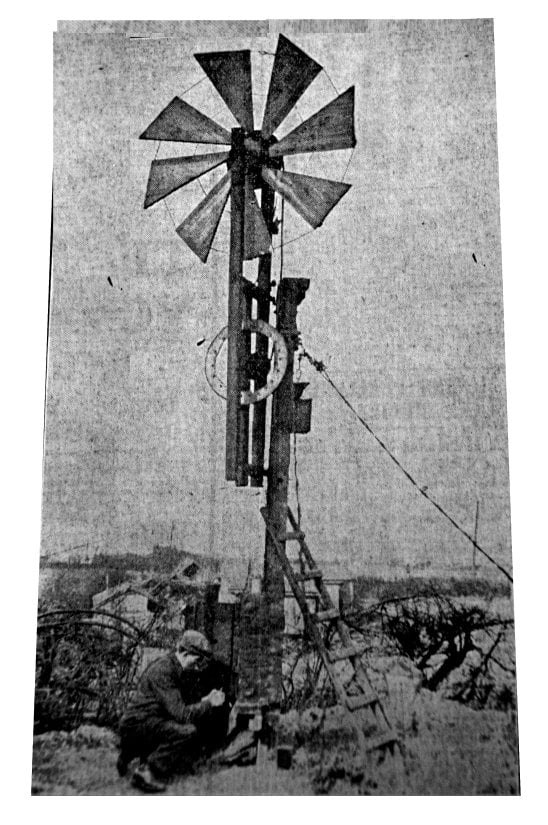
This interesting photograph shows a windmill which had been erected by Mr Frank Hepworth, in his allotment in Park Road, Mexborough, for the purpose of generating electricity.
Mr Hepworth, who has been experimenting with this branch of mechanic for some time, is 25 years of age, and is employed in the Denaby Mine as a signaller.
He has devoted a good deal of study to the possibility of applying wind power to the generation of electricity.
The Windmill shown in the photograph has eight wooden sails, and the gearing from the milll to the dynamo is 25 to 1. The dynamo is capable of an output of six volts, 7 amps, equal to 42 W, with cut out incorporated, and is waterproof.
The whole of the mill, gearing and dynamo is built into a wooden frame mounted on a post, and swings to an angle of 90°. The total height of the mill from the ground is 19 ½ feet.
An excellent opportunity of testing the efficiency of the mill was afforded on October 9 when the wind which blew constantly through the 24 hours attained a velocity of between 20 and 60 mph, the direction being south-west, backing to West. The total power produced was 96 amp hours at a pressure of six volts, equalling 576 Watt hours. The output was only used for 10 hours, to charge a 6 V 60 amp accumulator, and the rest of the powers was allowed to waste, the owner having no more batteries.
The defects of the mill revealed by this test were: that the mill, being of wood, was very heavy, and required a moderate wind to set it in motion. His maximum velocity was under 20 revs per minute, and the mill itself had to do 60 revs per minute before any current was available. So the designer, with the these defects in mind, experimented further and built another mill, with metal sails mounted on strip steel stays and a ball bearing hub, carried in a wooden frame mounted on a wooden base, swinging on a pivot and responsive to wind from any direction when properly finished and mounted on a post.
The transmission of power from the mill to the dynamo is by belt, the dynamo been mounted on a small platform, which is adjustable for tightening the bolts as required. The dynamo is mounted on the same platform as the mill and swings visit to the wind, thus dispensing with costly bevel gear arrangements.
This mill is calculated to obtain a speed of 500 revolutions per minute and therefore is only geared at 5 to 1.
As the designer soon discovered, the higher the gear the more power you require to drive, and so the second mill was built lightly, and as much friction as possible was eliminated. The number of sails were doubled – that is 16 instead of 8- to assist starting.
Mr Hepworth says that he has never seen or heard of any Windmill design like these two. He believes there is a great field open for experiment in the employment of wind power, and it does not think the Government of this country has realised the importance of encouraging research in this direction, as, for instance, the Dutch Government has.
He uses an ingeniously device in connection with his windmill. The electricity generated is made to light an indicator, which is seen through a mirror in the designer’s bedroom, while he is in bed in the windy night, he can see whether is mill is functioning.
Mr Hepworth is deeply interested in the subject and is ready at all times to enter into discussion upon it with anyone similarly interested.
